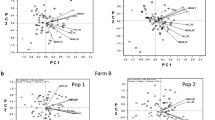Summary
Twelve varieties of tomato of economic importance and their hybrids (including reciprocals) were studied in four environments: inside and outside of greenhouses and with and without plastic mulching. Seven characters were recorded per plant per environment: (1) total yield, (2) fruit weight, (3) locules/fruit, (4) fruits/cluster, (5) earliness in maturity, (6) earliness in harvesting and (7) leaves between clusters. There was an almost general tendency for hybrids to show higher values than the parentals for characters (1), (4) and (7); the opposite was true for (2) and (3), even when the differences were not statistically significant at the 5% level. Environments were always highly significant; the effect of the greenhouse explained most of the variation. Genotype-environment interaction by regression analysis showed that the performance of the hybrids was generally higher than that of the parents for characters (1), (4) and (7). Total yield was higher, in general, in the most protected environments. Locules per fruit was very constant but when interaction did exist, the number of locules was higher in the less protected environments. Hybrids interacted with environments more strongly than parent lines. Earliness was the most environmental dependent characteristic the choice of early harvesting being irrelevant. Some of the hybrids obtained seem promising from a commercial point of view.
Similar content being viewed by others
Literature
Baroncelli, S.; Maggiotto, A.; Soldatini, G.; Buiatti, M. (1972): Genetic analysis of a tomato diallel cross. Z. Pflanzenzücht. 68, 149–154
Cuartero, J. (1976): Genética de los factores de rendimiento en tomate (Lycopersicon esculentum Mill.). Ph. D. Thesis, E.T.S.I.A. Cordoba (Spain)
Johnson, G.F.; Whittington, W.J. (1977): Genotype-environmental interaction effects in F1 barley hybrids. Euphytica 26, 67–73
Knight, R. (1973): The relation between hibrid vigour and genotype environment interaction. Theor. Appl. Genet. 43, 311–318
Nandpuri, K.S.; Kanwar, J.S.; Surjan-Singh, S. (1974): Genetic variability and genotype environmental interaction in tomato (Lycopersicon esculentum Mill.). J. Res. Punjab Agric Univ. 118, 242–246
Williams, W.; Gilbert, N. (1960): Heterosis and the inheritance of yield in tomato. Heredity 14, 133–149
Author information
Authors and Affiliations
Additional information
Communicated by J. Mac Key
Rights and permissions
About this article
Cite this article
Cuartero, J., Cubero, J.I. Genotype-environment interaction in tomato. Theoret. Appl. Genetics 61, 273–277 (1982). https://doi.org/10.1007/BF00273785
Received:
Issue Date:
DOI: https://doi.org/10.1007/BF00273785




